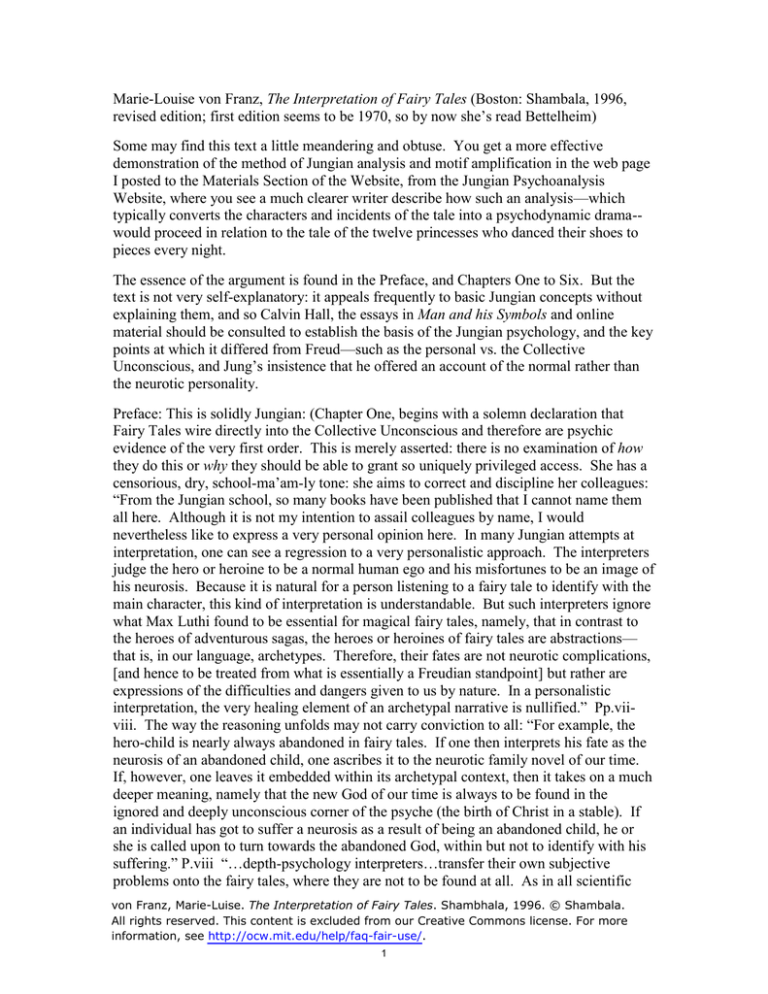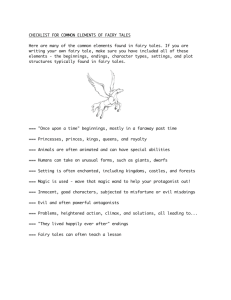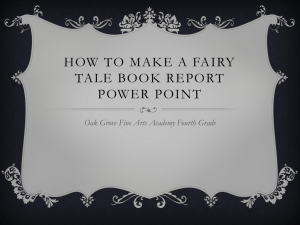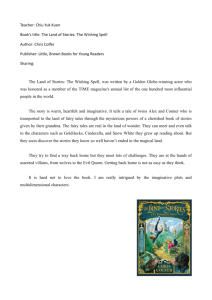
Marie-Louise von Franz, The Interpretation of Fairy Tales (Boston: Shambala, 1996,
revised edition; first edition seems to be 1970, so by now she’s read Bettelheim)
Some may find this text a little meandering and obtuse. You get a more effective
demonstration of the method of Jungian analysis and motif amplification in the web page
I posted to the Materials Section of the Website, from the Jungian Psychoanalysis
Website, where you see a much clearer writer describe how such an analysis—which
typically converts the characters and incidents of the tale into a psychodynamic drama-would proceed in relation to the tale of the twelve princesses who danced their shoes to
pieces every night.
The essence of the argument is found in the Preface, and Chapters One to Six. But the
text is not very self-explanatory: it appeals frequently to basic Jungian concepts without
explaining them, and so Calvin Hall, the essays in Man and his Symbols and online
material should be consulted to establish the basis of the Jungian psychology, and the key
points at which it differed from Freud—such as the personal vs. the Collective
Unconscious, and Jung’s insistence that he offered an account of the normal rather than
the neurotic personality.
Preface: This is solidly Jungian: (Chapter One, begins with a solemn declaration that
Fairy Tales wire directly into the Collective Unconscious and therefore are psychic
evidence of the very first order. This is merely asserted: there is no examination of how
they do this or why they should be able to grant so uniquely privileged access. She has a
censorious, dry, school-ma’am-ly tone: she aims to correct and discipline her colleagues:
“From the Jungian school, so many books have been published that I cannot name them
all here. Although it is not my intention to assail colleagues by name, I would
nevertheless like to express a very personal opinion here. In many Jungian attempts at
interpretation, one can see a regression to a very personalistic approach. The interpreters
judge the hero or heroine to be a normal human ego and his misfortunes to be an image of
his neurosis. Because it is natural for a person listening to a fairy tale to identify with the
main character, this kind of interpretation is understandable. But such interpreters ignore
what Max Luthi found to be essential for magical fairy tales, namely, that in contrast to
the heroes of adventurous sagas, the heroes or heroines of fairy tales are abstractions—
that is, in our language, archetypes. Therefore, their fates are not neurotic complications,
[and hence to be treated from what is essentially a Freudian standpoint] but rather are
expressions of the difficulties and dangers given to us by nature. In a personalistic
interpretation, the very healing element of an archetypal narrative is nullified.” Pp.viiviii. The way the reasoning unfolds may not carry conviction to all: “For example, the
hero-child is nearly always abandoned in fairy tales. If one then interprets his fate as the
neurosis of an abandoned child, one ascribes it to the neurotic family novel of our time.
If, however, one leaves it embedded within its archetypal context, then it takes on a much
deeper meaning, namely that the new God of our time is always to be found in the
ignored and deeply unconscious corner of the psyche (the birth of Christ in a stable). If
an individual has got to suffer a neurosis as a result of being an abandoned child, he or
she is called upon to turn towards the abandoned God, within but not to identify with his
suffering.” P.viii “…depth-psychology interpreters…transfer their own subjective
problems onto the fairy tales, where they are not to be found at all. As in all scientific
von Franz, Marie-Luise. 7KH,QWHUSUHWDWLRQRI)DLU\7DOHV. Shambhala, 1996. © Shambala.
All rights reserved. This content is excluded from our Creative Commons license. For more
information, see http://ocw.mit.edu/help/faq-fair-use/.
1
work, the subjective factor can never be entirely excluded. But I believe that by using the
basic tool of mythological amplification, one can hold in check such subjectivism and, to
some extent, thereby reach a generally valid interpretation.” P.viii [Would it be wildly
wrong to view this as an example of the cloak of “science” being flung over all manner of
craziness?]
“In what follows, my efforts are aimed at interpreting only a few classical stories, or
basic types of important fairy tale plots, as it were, in order to help clarify for the reader
the Jungian method of interpretation…” p.ix
Chapter 1 “Theories of Fairy Tales” “Fairy tales are the purest and simplest expression
of collective unconscious psychic processes. Therefore their value for the scientific
investigation of the unconscious exceeds that of all other material. They represent the
archetypes in their simplest, barest, and most concise form. In this pure form, the
archetypal images afford us the best clues to the understanding of the processes going on
in the collective psyche. In myths or legends, or any other more elaborate mythological
material, we get at the basic patterns of the human psyche through an overlay of cultural
material. But in fairy tales there is much less specific conscious cultural material, and
therefore they mirror the basic patterns of the psyche more clearly.” P.1 [Can we acquit
this of breathtaking textual naiveté? Has von Franz paused to consider where her sources
come from and by what process they reached the present? She takes it as axiomatic, that
these are direct emanations, not of the German folk soul, but of the universal human
psyche. A Sinologist or an Africanist would immediately also pounce on this as
Eurocentrism, and consequently blind cultural arrogance, in spades]
As we read we may find her bland acceptance of vagueness and imprecision also a little
startling: “In terms of Jung’s concept, every archetype is in it essence an unknown
[?unknowable] psychic factor, and therefore there is no possibility of translating its
content into intellectual terms.” At this point the reader may wonder: well, why go on?
Doesn’t this mean “game over”? A good many mystical assertions follow, including:
“Every archetype is a relatively closed energetic system, the energetic stream of which
runs through all aspects of the collective unconscious.” P.3.
Here’s her historical/contextual summary: “We read in Plato’s writings that old women
told their children symbolic stories—mythoi. Even then fairy tales were connected with
the education of children. In later antiquity Apuleius…built into his famous novel The
Golden Ass a fairy tale called ‘Amor and Psyche,’ a type of ‘Beauty and the Beast’
story…fairy tales have also been found in Egyptian papyri and stelai, one of the most
famous being that of the two brothers Anup (Anubis) and Bata. Is runs absolutely
parallel to the two brother-type tales, which one can still collect in all European countries.
We have written tradition for three thousand years, and what is striking is that the basic
motifs have not changed much. …we have information to the effect that certain themes
of tales go as far back as twenty-five thousand [ twenty-five hundred?] years before
Christ, practically unaltered.” P.4 These are sweeping claims for which very little direct
evidence (or argument) is offered. The fairy tale is normally considered to be a literary
extension of a wider pattern of folk tales, and to have a history not dating back
significantly before the Renaissance. “Herder said that such tales contained the remnants
of an old, long-buried faith expressed in symbols… Dissatisfaction with Christian
von Franz, Marie-Luise. 7KH,QWHUSUHWDWLRQRI)DLU\7DOHV. Shambhala, 1996. © Shambala.
All rights reserved. This content is excluded from our Creative Commons license. For more
information, see http://ocw.mit.edu/help/faq-fair-use/.
2
teaching and the longing for a more vital, earthy, and instinctual wisdom began then; later
we find it more explicitly among the Romanticists in Germany. It was this religious
search for something which seemed lacking in official Christian teaching that first
induced the famous brothers Jakob and Wilhelm Grimm to collect folktales’ P.4 She
actually uses the term “neopaganism”, but once again offers little or no evidence for this
assertion.
“…a strange unreliable, unscientific, and dishonest attitude has for a long time prevailed
toward fairy tales. So I always tell students to look up the original. You can still get
editions of the Grimm fairy tales in which some scenes have been omitted and those from
other fairy tales inserted. The editor or translator is sometimes impertinent enough to
distort the story without taking the trouble to make a footnote. They would not dare do
that with the Gilgamesh epic or a text of that kind, but fairy tales seem to provide a free
hunting ground where some feel free to take any liberty.
The Brothers Grimm wrote down their fairy tales literally, as told by people in their
surroundings, but even they could sometimes not resist mixing a few versions, though in
a tactful way.’ P.5 “Theodor Benfey tried to prove that all fairy tale motifs originated in
India and had migrated to Europe, while others…contended that all fairy tales were of a
Babylonian origin and had then spread through Asia Minor and from there to Europe.”
P.6 This is a reference to the once-powerful view of cultural transmission called
“Diffusionism”. I have posted a brief overview to the course site, but the useful
Wikipedia entry on “Trans-Cultural Diffusion” may also be consulted. Von Franz briefly
summarizes Ludwig Laistner whose “hypothesis was that the basic fairy tale and folktale
motifs derive from dreams.” P.7 Then we hear of Adolf Bastian (1826-1905) whose idea
was “that mankind has a store of Elementargedanken (elementary thoughts), which do
not migrate but are inborn in every individual, and that those thoughts appear in different
varieties in India, Babylonia, and even, for instance, in South Sea stories.” P.8 and she
notes commendingly how much this anticipated Jung’s thinking.
In her writing there is a casual acceptance of the possibility of bizarre events occurring
which will startle most rationalists. She’s doctrinairely narrow, too: “It is not my
intention to discuss here the many current sociological and feminist theories of fairy tales,
for out of ideological prejudice or resentments, they distort the basic facts”.
Chapter 2: ‘Fairy Tales, Myths, and Other Archetypal Stories’
Here is the main thesis again, that Fairy Tales carry one closer to the collective
unconscious than myths or folk tales, because they represent a kind of geological
bedrock, the essence of the whole matter, and hence are immensely powerful analytical
tools. “to me the fairy tale is like the sea, and the sagas and myths are like the waves
upon it; a tale rises to be a myth and sinks down again into being a fairy tale.” P.26
Chapter 4: “A tale Interpreted: ‘The Three Feathers’. It’s about a king who has three sons
and he wants to know who to pass the kingdom on to; the first two sons seem normal
enough guys but the third is a seeming simpleton, ‘Dummling’ in the English translation.
The Jungian stuff comes in somewhat thus: as it well known, the human personality is
fourfold, and this is symbolized by the king and the three sons; however, the feminine
von Franz, Marie-Luise. 7KH,QWHUSUHWDWLRQRI)DLU\7DOHV. Shambhala, 1996. © Shambala.
All rights reserved. This content is excluded from our Creative Commons license. For more
information, see http://ocw.mit.edu/help/faq-fair-use/.
3
principle is conspicuously lacking and it is this that Dummling re-instates by his
openness to experience and his tolerance and kindness. As usual the reading seems
wholly arbitrary to somebody who is not convinced, a priori, that Jungian psychology has
the force of a law of nature. Anyway, the king sends his sons out to find a magical
carpet; Dummling of course goes to the Earth Mother/Frog and gets one; the carpet
represents the mystical design of the unconscious forgotten in the too rational kingly
court; then the ring—this too symbolizes a lost wholeness and once again the feminine
principle, suppressed at court. “On the earth, at the king’s court, a conscious attitude rules
which sees the anima only as a frog. This means that in the conscious realm an attitude
prevails which has a contemptuous ‘nothing but’ outlook on the phenomenon of Eros,
and in those circumstances the anima appears, in the eyes of these men at the king’s
court, to be a frog. We have a modern example of this in the Freudian theory in which
the whole phenomenon of Eros is reduced to the biological sex function. Whatever
comes up is explained in the ‘nothing but’ terms of rational theory. Freud had very little
recognition of the feminine element and therefore always explained it as sex. From the
Freudian standpoint even a Gothic cathedral is only a morbid surrogate for unlived sex,
as is proven by the phallic towers! Viewed from such a standpoint, the sphere of the
anima cannot exist. However, it is not only the Freudian attitude that does this to the
anima. A moral prejudice against Eros or a repression of the Eros principle for political
or other reasons also may reduce the anima to a frog or a louse or whatever other form
and level she may be repressed into. Then a man’s anima becomes as undeveloped as the
Eros function of a frog.” Pp.84-5 When Dummling eventually brings up a frog princess,
a carrot coach is a necessary part of her transformation; much fun is had with carrot
symbolism, interpreted to mean men must embrace their nocturnal sexual fantasies to
achieve wholeness. “When Dummling brings together the young toad and the vehicle,
then the toad turns into a beautiful woman. This would mean, practically, that if a man
has the patience and courage to accept and bring to light his nocturnal sex fantasies, to
look at what they carry and to let them continue, developing them and writing them
down…then his whole anima will come up into the light.’”P.88
Chapter 6: “’The Three Feathers’ Completed”
This turns to the final test where the brides have to jump through the ring, and only
Dummling’s can do it. Von Franz points out that this is a common Fairy Tale pattern:
three tests, three adventures, three symbolic interludes, then a final fourth forming the
coda. “As Jung himself discovered, one can find the way back to …living
symbolism…We get to it by attending to the unconscious and our dreams. By attending
to one’s dreams for a long time and by really taking them into consideration, the
unconscious of modern man can rebuild a symbolic life. But that presupposes that you
do not interpret your dreams purely intellectually and that you really incorporated them
into your life…This means no longer living merely with the reasonableness of the ego
and its decisions but living with the ego embedded in a flow of psychic life which
expresses itself in symbolic form and requires symbolic action.” Pp.96-7 When, as in
some versions, the frog princess cries “embrace me and let us sink” and Dummling grabs
her and jumps into the pond which enables her to transform into a beautiful woman, what
this means is “Acceptance of the frog and the frog’s life implies a jump into the inner
world, sinking down into an inner reality…” p.98 There’s a wonderfully daft Russian
von Franz, Marie-Luise. 7KH,QWHUSUHWDWLRQRI)DLU\7DOHV. Shambhala, 1996. © Shambala.
All rights reserved. This content is excluded from our Creative Commons license. For more
information, see http://ocw.mit.edu/help/faq-fair-use/.
4
version cited here in which the frog princess conceals food up her sleeves and as she
dances: “she waves her right arm and out of it falls a bit of the food, which is transformed
into a garden with a pillar in it. Around this a tomcat circles, then climbs up it and sings
folk songs. When it comes down it tells fairy tales.” P.101 “In this way you see even
more clearly that the anima creates the symbolic life, for she transforms ordinary food for
the body into spiritual food through creating art and mythological tales; she restores
paradise, a kind of archetypal world of fantasy. The tomcat represents a nature spirit
which is the creator of folk songs and fairy tales. It also shows the close connection of
the anima with man’s capacity for artistic work and with the fantasy world.” Pp.100-101
These three chapters complete her analysis of ‘The Three Feathers’.
Chapter 7: Shadow, Anima, and Animus in Fairy Tales
von Franz states that most tales are centered on the self, but “we also find in many stories
motifs which remind us of Jung’s concepts of the shadow, animus, and anima.” P114
The “scientific”, objective nature of these functions is again heavily stressed: “we must
again realize that we are dealing with the objective, impersonal substructure of the human
psyche and not with its personal individual aspects.” P.114
This seems to involve central figures in a kind of doubling in which they split into light
and dark aspects of the things they represent. To illustrate this she recounts the
Scandinavian folk tale “Prince Ring” about a prince out hunting who spies a magical hind
with a ring around her horns. Pursuing her he becomes separated from his companions in
a fog and discovers an old woman hunched over a barrel who invites him to find the ring
at the bottom of it; reaching in Ring is trapped by the old woman in the barrel, and
pushed into the sea; floats around a while and comes to the land of the giants; is
befriended by a couple of elderly affable giants who say they are shortly going to die and
he can have anything they possess, except what is in the kitchen (the bloody chamber
motif again?) What is in the kitchen is a little magic talking dog, called “Snati-Snati” and
Prince Ring makes off with it. They travel on to a kingdom where the prince asks winter
lodgings, and Snati helps him perform impossible tasks and win the hand of the king’s
daughter. The final task involves a desperate struggle with a family of ogres who possess
golden treasures. The king’s jealous minister is coming in the night to murder Ring in his
bed, but the dog tells him to swap places and bites off the hand of the would-be assassin;
when next day the false minister claims Ring has tried to murder him, and holds up the
bloody stump as evidence, the clever dog produces the hand with the assassin’s blade still
clutched in it; the minister is hanged. It ends “Ring married the princess, and on the
wedding night Snati-Snati was allowed to lie at the foot of the bed. In the night he
regained his true form, that of a king’s son also named Ring. His stepmother had
changed him into a dog, and he could only be redeemed by sleeping at the foot of the bed
of a king’s son. The hind with the golden ring, the woman on the beach, and the
formidable witch-giantess were in reality different guises of his stepmother, who wished
at any price to prevent his redemption.” Pp.117-8 von Franz explains this with reference
to the myth of Heracles and the golden hind of Artemis “which he pursued for a year but
was not allowed to kill…Artemis, the famous huntress, is often transformed into a deer;
in other words, the hunter and the hunted are secretly identical.” P.118 von Franz says
that in giving the hind horns, the obvious anima-figure is transformed into something
von Franz, Marie-Luise. 7KH,QWHUSUHWDWLRQRI)DLU\7DOHV. Shambhala, 1996. © Shambala.
All rights reserved. This content is excluded from our Creative Commons license. For more
information, see http://ocw.mit.edu/help/faq-fair-use/.
5
more hermaphrodite, and, hence, shadowed. [true indeed, at least from an anatomical
point of view: except for reindeer and caribou, females do not have horns] Of course, in
presenting this folk tale as a psychic allegory, von Frank is being strongly anachronistic;
she shows little interest in what the host society may have meant by this curious tale in
historically identifiable times. One is also troubled by the routine way in which Jungian
analysts collapse character boundaries, and what had seemed separate people are claimed
to be but various aspects of one. The fact that the prince is called ‘Ring’ links him with
the ring of the magic hind, and soon enough we find von Frank talking about
harmonization of personality and consciousness. For some reason Ring has to find his
own opposite, although there is no indication of why this should be so. The mystic wood
into which he ventures is, of course, the unconscious realm. The ring is a symbol of the
self, and pursuing it the hero falls into the hands of Snati-Snati’s stepmother, here an
ambiguous figure at once threatening and ultimately empowering. Once in the barrel and
cast adrift on the sea, “One can say that Prince Ring is now under the spell of a negative
mother-image which seeks to cut him off from life and to swallow him.”p.121 There
follow various sentiments on the subject of islands, then some interesting stuff about
giants. They represent big forces of energy, apparently; the kitchen is significant, too:
“Snati-Snati, who is the complementary other side of the hero [is found in the kitchen].
Historically, the kitchen was the centre of the house and was therefore the place of the
house cults…the kitchen is analogous to the stomach. It is the centre of emotion…’
p.124 von Franz continues, “It should be noted that the king, not the real father of Ring,
is the father of the anima and that the mother is missing—a lack that connects with the
fact that both Ring and the dog are under the influence of a negative mother-image.
Moreover, the precious treasures that belong to this king are no longer with him, but are
hoarded by a baneful giant-mother who lives with her family on a mountain.” P.125 The
evil minister, Rauder, is claimed to represent—for some reason--the hero’s own dark
emotion and impulses. We are reminded that the wood symbolizes the unconscious and
so a journey into it is a descent into the unconscious. “In order to accomplish the
difficult tasks, Prince Ring has to have the help of his other shadow side, the dog, which
increasingly takes the imitative. The two become strongly allied, and the hero acquires
the help of the instincts in the form of the positive shadow.” P.128 Then the usual
Jungian symbolic amplification takes place and we learn much about the implications of
mountains, then, p.131 a heap of dog symbolism. I note that von Franz seems to have
overlooked that the dog can only turn back into a prince reversing his stepmother’s curse
by sleeping at the foot of the bed of a king’s son; a thing he could have done at any point
in the tale. Rauder’s ‘animal’ destructiveness is—fittingly—neutralized by an animal.
Much rather banal moral reflection follows including the interesting point that evil cannot
always be subliminated; sometimes it must be repressed. P.132 Even the common facts
of history become vague, semi-intelligible, when forced into this strange perspective:
“The Nazis put the ideal of individuation into their program, but that ideal was spoiled
and made soulless by false collective interpretations.” P.133 Then we get a chart
showing the narrative arc, in fact a circle, of the tale, and learn that the seaside witch, and
the giantess and the magic hind are all in fact secretly the same, i.e. they’re aspects of the
evil stepmother. At the end of all this thrashing about comes the bottom line: “This fairy
tale in its entirety represents an energetic process of transformation within the Self, and
one may compare this to the transformations that take place within an atom or its nucleus.
von Franz, Marie-Luise. 7KH,QWHUSUHWDWLRQRI)DLU\7DOHV. Shambhala, 1996. © Shambala.
All rights reserved. This content is excluded from our Creative Commons license. For more
information, see http://ocw.mit.edu/help/faq-fair-use/.
6
// To sum up…the fairy tale does not represent a personal shadow figure, but the
collective shadow of the collective hero figure. [Presumably this idea is a back-formation
from the initial concept of the collective unconscious; if you have got a collective
unconscious then, presumably, you might need collective personalities for it to be lodged
within, but this is otherwise unexplained]. It consists of an animal double which is
positive, and an evildoer who is destructive. Actually, the animal double is more an
undeveloped aspect of the Self.” P.136 One might wonder what sort of enrichment can
be gained from such a conclusion; it tells one little or nothing about the mind, or the tale].
Then we move on to the story of “The Bewitched Princess” , and this, apparently, is
about finding and incorporating or otherwise coming to some kind of positive
accommodation with the Anima, during which we learn that an unreconciled or badlyintegrated shadow can cause all kinds of mischief. Then there’s the story of the guy who
meets a troll maiden and is invited to forswear his religion; the interpretation seems oddly
blind to the theological implications. In the course of this latter, we learn about the
symbolism of The Wise Old Man, then on the symbolic import of swords, fish, wheels,
vampires, hearing more about the layered composite nature of the collective unconscious
deposited over long periods of time: you might be Christian, but the collective
unconscious is pagan. Pp.158-9 gives a passage on links between alchemy and
psychology, then we return to the image of the Wise Old Man, and the symbolic
implications of Wotan (see also p.176). And then the symbolic implications of milk. “On
the wedding night the hero must plunge the princess three times into water until she is
restored to her former self. In the Norwegian version she has to wash off her troll skin in
milk. In the ancient mysteries milk played a prominent part as nourishment for the newly
born initiate. In the Dionysian mountain orgies, the Maenads drank milk and honey
flowing freely from the earth. Milk and honey were also the food of the reborn in early
Christian baptism. In an ode of Solomon milk is extolled as a symbol of the friendliness
and kindliness of God. Saint Paul says that the new Christians are children drinking the
milk of the new doctrine. Milk is a symbol of the beginning of divine rebirth in man. In
ancient Greek sacrifices, milk was offered to the chthonic gods and to the newly dead. In
these cases milk is cathartic (cf. the many German superstitions about obstructive demons
bewitching milk and turning it blue, and the many prescribed precautions against them).
Hence the washing of the anima in milk means the purging of the demonic elements in
her as well as the purging of her link with death.” Pp.160-161 Then comes a section on
“The Female Shadow” pp.163-8, which I’ve indicated should be skipped. Then on to
“The Power of the Animus” where we learn that there is “an important difference
between the anima and the animus. Man in his primitive capacity as hunter and warrior
is accustomed to kill, and it as if the animus, being masculine, shares this propensity.
One might speculate, once again, on this seemingly bold new interpretative strategy,
serving only to reassert the tirades old stereotypes about masculinity and femininity
current during the 1950s, see for example p.174 below] Woman, on the other hand,
serves life, and the anima entangles a man In life.” Pp.169-70 So finding the anima is a
positive step for a man; it seems clear, however, that on the contrary a woman should
shun her animus. For further gender-stereotypical passages see p.171, bottom, and p.174
von Franz, Marie-Luise. 7KH,QWHUSUHWDWLRQRI)DLU\7DOHV. Shambhala, 1996. © Shambala.
All rights reserved. This content is excluded from our Creative Commons license. For more
information, see http://ocw.mit.edu/help/faq-fair-use/.
7
MIT OpenCourseWare
http://ocw.mit.edu
21L.430 / CMS.920 Popular Culture and Narrative: Use and Abuse of the Fairy Tale
Fall 2015
For information about citing these materials or our Terms of Use, visit: http://ocw.mit.edu/terms.







